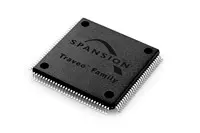Electronics News
Archive : 2 October 2014 год
 Spansion has expanded its Traveo range of automotive MCUs with the addition of a device which combines 2D and 3D graphics with a Cortex-R5 core.
Spansion has expanded its Traveo range of automotive MCUs with the addition of a device which combines 2D and 3D graphics with a Cortex-R5 core.
Matthias Bräuer, director of automotive MCU marketing, said: "We are combining a traditional MCU with graphics capability. The device is aimed at hybrid clusters with pointers and a display. It not only supports 2D graphics, but also allows manufacturers to take a step into 3D."
There will be two variants: the S6J324C series, which enables 2D graphics; and the S6J326C, which supports 2D and 3D graphics. Both series support the Spansion HyperBus interface. Bräuer noted: "Although this device integrates graphics memory on chip, it still needs to access external memory. HyperBus allows data to be transferred at up to 333Mbyte/s."
In terms of graphics, the S6J32x parts are capable of supporting up to six standard gauges, as well as head up displays. "In some cases," Bräuer continued, "clusters won't have traditional pointers. Instead, there will be virtual instruments and the graphics element can generate fast rotating elements for a natural look." The display controller can handle two outputs as well as accepting a video input. Safety concerns are addressed by displaying safety critical information using a separate graphics layer.
Author
Graham Pitcher
Source: www.newelectronics.co.uk
 Toshiba has used its 15nm process technology to fabricate what it claims to be the world's smallest embedded NAND flash memory modules.
Toshiba has used its 15nm process technology to fabricate what it claims to be the world's smallest embedded NAND flash memory modules.
The 16GB memory devices are compliant with the latest e·MMC standard and are designed for applications such as smartphones, tablet PCs and wearable devices.
Sample shipments are available now, with 8, 32, 64 and 128GB products due to follow shortly.
Toshiba says the chips can reduce package size by around 26%. They are also designed to improve read and write speeds by 8% and 20% respectively.
The chips integrate a controller that manages basic control functions for NAND applications.
Additional features include BKOPS control, Cache Barrier, Cache Flushing Report, and Large RPMB Write.
Author
Laura Hopperton
Source: www.newelectronics.co.uk
Teledyne LeCroy (Chestnut Ridge, NY) introduces the WaveSurfer 3074, extending the bandwidth range of the popular WaveSurfer 3000 series of oscilloscopes to 750 MHz. WaveSurfer 3000 oscilloscopes feature the MAUI advanced user interface, previously available only on higher-end oscilloscopes. This advanced user interface seamlessly integrates a deep measurement toolset and multi-instrument capabilities into a cutting edge user experience centered on a large 10.1” touch screen, the largest display and only touch screen in this class of oscilloscope. Other features include:

• Bandwidths from 200 MHz to 750 MHz.
• 10 Mpts/ch memory and up to 4 GS/s sample rate.
• Waveform generation with a built in function generator.
• Protocol analysis with serial data trigger and decode.
• Logic analysis with an available 16 channel mixed signal option.
For more information on the WaveSurfer 3074, visit www.teledynelecroy.com.
